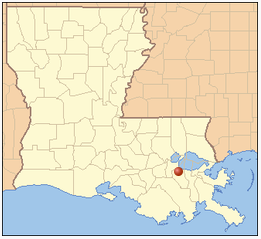| Home | Search | Emissions | Pollutants | About the Database |

Motiva Enterprises (1406), Norco
LDEQ Accident Report
| Accident # | 87197 |
| State Police # | 06-02322 |
| Accident Date | 2006-04-15 |
| Report Date | 2006-10-10 |
| Follow-up Date | 0000-00-00 |
| Follow-up: | No |
Pollutants Released
| Pollutant | Duration | Point Source | Greenhouse Gas | Criteria Pollutant | Ozone forming chemical | Amount of Release |
| Sulfur Dioxide | RCCU Flare (EPN 8-84) and GO-1 Elevated Flare (EPN 1-90) | NO | YES | NO | 4,418.0 pounds | |
| Nitrogen Oxide | RCCU Flare (EPN 8-84) and GO-1 Elevated Flare (EPN 1-90) | NO | YES | YES | 1,093.0 pounds | |
| Carbon Monoxide | RCCU Flare (EPN 8-84) and GO-1 Elevated Flare (EPN 1-90) | NO | YES | NO | 6,236.0 pounds | |
| Particulate Matter | RCCU Flare (EPN 8-84) and GO-1 Elevated Flare (EPN 1-90) | NO | YES | NO | 216.0 pounds | |
| Volatile Organic Compounds (VOCs) | RCCU Flare (EPN 8-84) and GO-1 Elevated Flare (EPN 1-90) | NO | NO | YES | 7,291.0 pounds |
Accident Classified As: Reportable Quantity
Cause of Problem: Human Factors
Motiva's Residual Catalytic Cracking Unit (RCCU) experienced a shutdown, causing the Main Fractionator overheads and Debutanizer overheads to be vented to the RCCU Flare (EPN 8-84) and the Shell Chemical GO-1 Elevated Flare (EPON 1-90). In addition, a release of propylene and butylene was generated from a RCCU atmospheric relief valve (RV-7205). Prior to the release on April 15, 2006, the RCCU experienced an unanticipated loss of level control in the Reactor Stripper vessel. At this point, operations had to place the stripper level control system in manual in an unsuccessful attempt to pro-actively control the level. Consequently, operating personnel were unable to fully determine and correct the root cause for the process upset, thus the decision was made to shut the RCCU down in order to safely stabilize the unit conditions. Operations utilized the Instrument Protective Function J-1 to safely divert feed from the unit and completed the shutdown per existing RCCU procedures.
Discharge Preventable - Yes
Notes/Remedial Actions
Immediate corrective actions: The Wet Gas Compressor was kept running in recycle mode to minimize start-up flaring; the Main Air Blower was left running after the unit tripped; the duration of time the unit tripped and the time feed was introduced to the unit was kept relatively short; startup was performed per existing unit procedures. Motiva stated remedial actions as follows: Research modifications to the Reactor Stripper Vessel to improve stability of the catalyst flow in the Catalyst Standpipe; inspect the burp tube on the Catalyst standpipe; repair local flow indicators on the fluidization steam nozzles at the CS; develop a hot stand-by procedure for quick acquisition to understand the unit's status in terms of being ready for a unit restart. Flaring was not continuous throughout start and end dates.

Connect With Us: